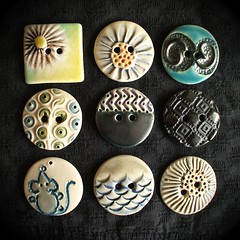
The Latest
Originally uploaded by la_v_i_k_a
It's not a bad return when 20, out of a freely experimental load of 100, come back worthy of production.
With this kiln load, the ratio was nearly reversed...and I am very happy.
Expect more pictures.

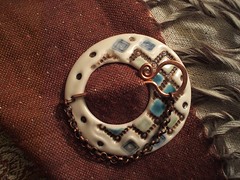
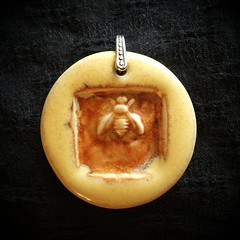
That famous tag line from Orbit Gum commercials.
Now, there's Orbit Mist, a hydrating gum.
Do they market it in Germany? Would they leave out an entire market?
Why am I asking?
Mist means manure (really, the four-letter manure).
Dirty mouth?

 I'm always on the lookout for clothing items that have large buttons, so that I can take them right off!
I'm always on the lookout for clothing items that have large buttons, so that I can take them right off! Having whip stitched the buttonhole closed, I sewed a male snap part to the middle of the backside of the closed buttonhole. At that point, the vest could be snapped together, but had a blank, buttonless front.
Having whip stitched the buttonhole closed, I sewed a male snap part to the middle of the backside of the closed buttonhole. At that point, the vest could be snapped together, but had a blank, buttonless front. The last step was to sew a male snap part onto the back of my Dancer button and snap it onto my garment.
The last step was to sew a male snap part onto the back of my Dancer button and snap it onto my garment. This blog never has been conventional & this won't help ;)
I got a bread machine at the second hand store earlier this year. Long years of no time for handmade bread (I get called away for taxi duties just about the time I should be kneading or right before the end of baking!) and I'd heard less than rave reviews regarding machine fare. However, knowing time had probably led to improvements and after reading some encouraging stories, I got one (second hand store, but first hand machine: never used!).
It took a little while to get used to. Liquids are the controlling substance for handmade loaves; you can always adjust flour. However, pan limitations make dry ingredients the limiting factor for machine-made loaves; it's the liquids that must be adjusted!
Enough talk. Here's two base recipes, one for rye and the other for wheat. They are easy to modify...add things you like!
Rye Bread
This recipe is for a 2lb loaf. I like to put the first three ingredients into a 4 cup measuring cup, because that's perfect.
1 C Dark Rye Flour
3 C Unbleached White Flour or Bread Flour
3 TBS Gluten Flour --this makes chewy Euro (German) style bread.
Add to bread maker pan:
2 strict tsp salt (or 10g)
1 TBS Demerara Sugar (I like it, less processed...it's only to feed the yeast)
2 TBS Oil
1-1/2 Cup Warm Water
-Dump 4 Cup mixture into bread maker pan, on top of liquids.
-Make a small well on top and add 1 TBS yeast (or 1 packet regular, NOT quick acting) (or 9g)
White Bread bake setting
2lb Loaf Whole Wheat Bread
In a 4 Cup Measure:
3 Cups Unbleached Flour
1 Cup Whole Wheat Flour (Put it in on top of white flour. Should go into pan first, & soak)
3 TBS Gluten Flour
Into Bread Pan:
3 TBS Oil
1-1/2 Cups + 3TBS Warm Water
2 tsps salt (complete tsps this time)
1 TBS Demerara Sugar
If you increase Whole Wheat, you'll need to increase water.
For both WW and Rye, you could go up to 1/3 ratio. 1.33 C/ 2.66 C White
1 TBS extra water if you increase Whole Wheat to 1.33 Cups
-Dump 4 Cup mixture into bread maker pan, on top of liquids.
-Make a small well on top and add 1 TBS yeast (or 1 packet regular, NOT quick acting) (or 9g)
Whole Wheat bake setting
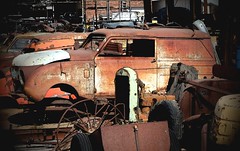
My cousin's property around their home was "shaved" into a nice lawn, beyond which the remainder was left to grow. Just over the line, side by side, sat two old Chevy's-- full of dust, cobwebs and a variety of spiders. Despite my fear, I would climb into the cars. The enticement to go on long imaginary drives with my cousin Bonnie was way too hard to resist.
She drove. I kept an eye on the spiders.
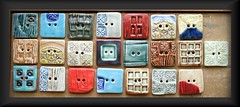
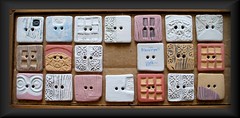
This set is now ready to be fired. Many risks here: I can guess about how some glazes will behave together, but I cannot know for certain. And, here I'm using many of them over translucent porcelain, for the first time.
During firing, porcelain becomes a ceramic that is nearly glass; its surface vitrifies and almost self-glazes. That changes the behavior of the underglazes and glazes that sit on it.
Yes, for those who might have noticed: I glazed on greenware and will fire once to maturity. I single-fire.

In the photo that accompanies my previous post below, the porcelain clay has been patterned, cropped, drilled, trimmed, beveled and sponged.

Having lost contact with women--net friends-- in Tripoli, how to express what it means?
Eman el Obeidi giving voice.
Admiring for quite a while now, I chose Hibo's photographs of the Old Doors of Tripoli, here as inspiration and reference for these buttons, which are still green--unfired.
Doors...for so many reasons.
I have trepidation. Is it trivial to reference so much in buttons? What happens when I sell my buttons? Probably, artists who have long known they are artists have already answered such questions for themselves. I'm not sure I have .
I want people, I want other women, to care. To take it upon their clothing.
And if they don't know and they don't care?
Maybe some satisfaction in knowing they have unwittingly been made to bear witness.